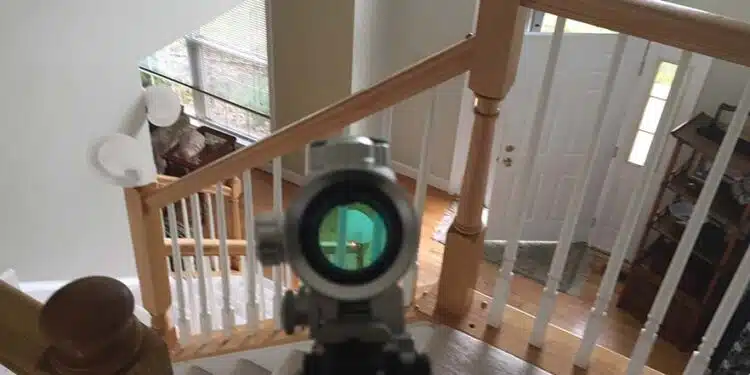By Paul Evancoe
When practicing shooting skills, most shooters aim at the bullseye, striving for tight groups, and leave the range believing they are adequately skilled to defend themselves. Sadly, few properly practice the skills necessary to stop an opponent and win in a gunfight. There is a difference between target practice and self-defense shooting.
Target practice is all about hitting the bullseye under range conditions in a non-stress environment. The opposite is true in real-world, self-defense scenarios where grouping and score don’t matter much. Self-defense shooting focuses on hitting a dinner-plate-sized center of mass on the first shot from the ready position in a life and death gunfight, under all environmental and lighting conditions. What does this really mean and how does one practice the necessary gun skills on the range to win in a real-world gunfight? The answer is twofold.
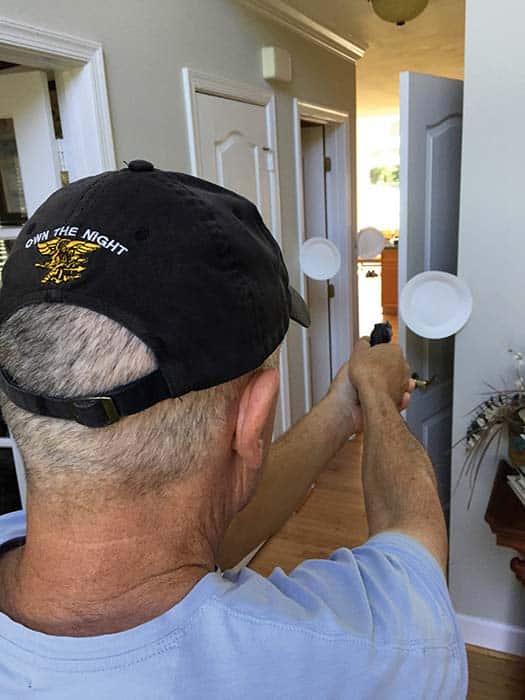
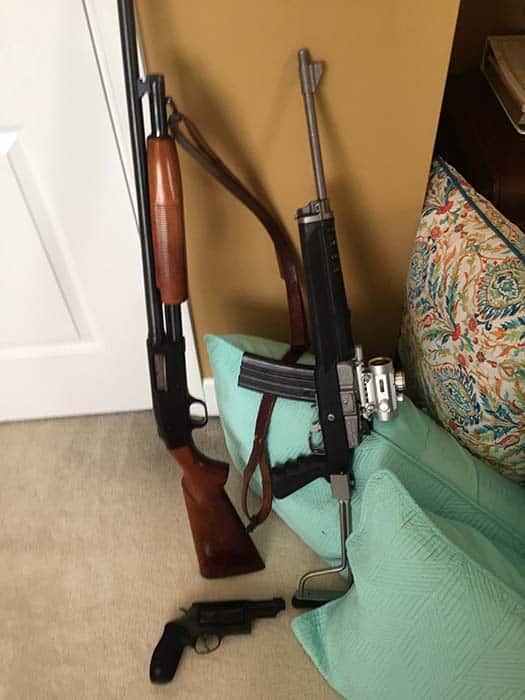
The first phase of the solution requires building total familiarity with the gun(s) you intend to use for defense. The objective of this first phase is to develop “muscle memory.” We’ll define muscle memory as becoming so familiar with a particular firearm, or firearms, that you no longer have to think about how to operationally use them. You should be completely familiar with its “feel” and operating it; e.g., wearing/carrying, drawing, acquiring the target, pointing it on target, firing it and reloading it when necessary.
This can be accomplished at home—no range time is necessary. For example, if you’re using a handgun for carry, you should begin by repetitively practicing (for hours), wearing the holstered gun, drawing from your carry holster, pointing it on target, dry-firing at dinner plate-sized (12-inch center of mass) targets, along with regular magazine changes or revolver speed loading drills. It should go without saying, but obviously you’ll want to use snap caps in your weapons for your dry fire drills.
A technique employed by many gunfighters is to use 12-inch paper plates as practice targets. Why? A 12-inch plate, if held against one’s chest, covers the human body’s vital organ center of mass. It is anywhere within this specific area where the first and second shot (in a double tap) should be placed. Paper plates can be easily taped chest-high to a wall or other furniture around the house or stapled to tree branches outdoors for dry firing practice. These are the practice targets you should use to develop muscle memory.
Particular attention should be given to maneuvering and shooting (dry fire) around the house at these center of mass plate targets, rehearsing your movement on a predetermined path to counter the threat to yourself and/or others. A number of liberal states, for example, have “retreat laws” that require a home defender to retreat within his home until he can retreat no further before engaging an intruder. Right or wrong, this means you cannot open fire, unless fired upon, by the armed intruder who has just broken down your door, without first retreating to a place within your home where you can retreat no further. Only then can you legally engage your assailant (and win in the ensuing court battle you will surely face).

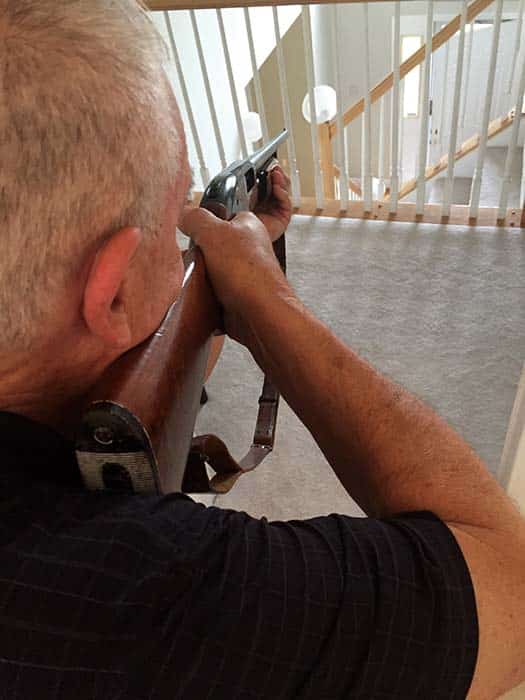
So—in the above scenario, preplanning various routes to the retreat location where you will make your stand and rehearsing that route with the weapon(s) you will be using at the ready is vitally important. Tape the center of mass plates on the walls at your critical defense points along the way, point on those targets as you move and dry fire. Conduct this practice drill often and do it under various lighting scenarios to become familiar with your flashlight and/or night sights. Practice your movement exactly as you intend to move when defending yourself.
There is another distinction that needs definition and understanding—the difference between concealment and cover. “Concealment” simply means you’re concealed or hiding behind something so your opponent can’t readily see you. That could be something like a sofa, a door or even a thin inside room wall. All of these examples provide concealment but not cover.
“Cover” can also provide concealment, but cover also protects you from bullets. Cover will save your life in a gunfight, concealment won’t if your opponent happens to see you. Therefore, as you plan your egress route to the point where you intend to make your stand(s), seek out location(s) that will protect you from penetrating fire. A single drywall (drywall/2×4 stud construction common in newer homes) will not provide cover unless you can stand behind several wall thicknesses.
These techniques should also be rehearsed outdoors in and around cars in a parking lot scenario, as well as your driveway parking, or garage-parking scenario. In these cases you’re using the vehicle’s engine block and transmission for cover, engaging your opponent from the front, back or side of your automobile as necessary. You’ll be shooting through windows and windshields, around and beneath the vehicles with the goal of exposing as little of yourself as you can to your opponent(s)—using the vehicle for concealment and cover. Again, this can be done by taping paper plates, representing your opponents’ vital area center of mass, as targets at various locations around your parking area. Practice, drawing, pointing on them and dry firing. Practice identifying and retreating to a cover position where you can engage your opponent(s).
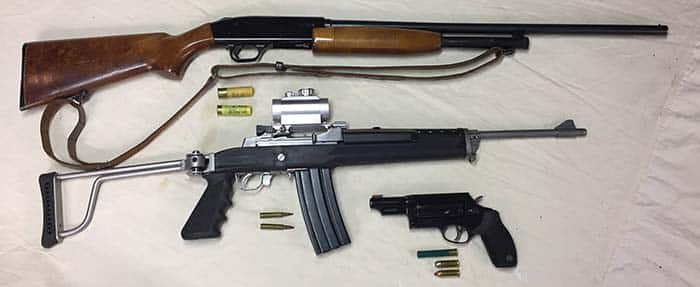
Always be aware of what’s downrange beyond your targets. This is important in practicing your field of fire. Liability resulting from lethal collateral damage from gunfire that misses its target, or completely penetrates it and keeps on going, falls squarely upon you as the shooter. Wherever possible, plan and practice your dry fire drills with the downrange impact area in mind.
Some of these techniques can be practiced at an indoor range and employ live fire, but instead of using traditional bullseye targets, use paper plates. Hang them chest high. If the range safety rules permit, practice drawing and shooting a double tap (two fast consecutive shots) at your paper plates, aiming for the center of mass. Punching holes anywhere within the plate’s 12-inch diameter is completely acceptable accuracy for gun fighting.
Many ranges will not allow a shooter to practice by drawing a holstered firearm. Rather, they strictly require that once loaded, the firearm be placed on the shooting bench in front of the shooter and not be picked up until ready to shoot at the target. Restrictions like this greatly reduce the effectiveness of practicing your self-defense shooting skills and provide little more than firearm familiarity (“feel”). Even so, you can practice by gripping and holding the gun at the ready, pointing the gun downrange, raising it on target and firing at a center of mass (paper plate) target. Double tap if permitted. Return to the ready position and repeat these steps. As you can see, this is very different from target shooting.
This brings us to the second phase; developing and practicing your “full mission profile” or FMP for short. The FMP was more or less already suggested in the preceding discussion. Regardless, your gun fighting practice should be based on FMPs. You should therefore develop a different day/night FMP for every conceivable scenario you might encounter; e.g., walking to/from your car, into/from your home, or apartment, awakened by an intruder while in your bedroom, while watching TV, seated at the dinner table or while at work (if you carry there) or sitting in your car at a red light, etc. The FMP should factor your immediate defensive reply and then rapid movement to a covered defensive stand location. All of these require FMP muscle memory practice. The objective is to be able to move and shoot as necessary without having to question direction or firearm operation.
This level of familiarity will give you a clear edge in a gunfight. You will already know what you intend to do. You’ve rehearsed it dozens of times in and around the locations you frequent. You know what you will do next, and you’re mentally prepared to do it. This will greatly reduce your confusion when you’re in a life threatening, overwhelmingly stressful scenario. It will allow you time to make rational decisions and engage your target effectively vice wildly, or worst case, not at all because you’ve frozen. Most importantly, it will greatly reduce your margin of error and increase your chances of survival.
To a lesser extent, the second phase also involves the weapon(s) you intend to use. Your choice of carry and home defense weapons is critically important because they are most often not the same weapon. All too many times people make the wrong choices—choices that complicate their ability to defend themselves in a gunfight scenario. Bigger is not necessarily better. If you have a small hand and a small body, choosing a 12-gauge auto-loading shotgun with rifled slugs for home defense or a 1911 .45 pistol for personal carry are probably not good choices. Better choices might be a 20-gauge pump action shotgun with 00 buck shot and a Smith and Wesson .357 model 340 revolver—both simple to operate and maintain, and they are very lethal.
Your choice of firearms should be based on commonsense and purposeful analysis of your operating environment and your shooting acumen. If you live in a vinyl-sided condo or a row home built with drywall/frame construction, you must take into account the wall penetration capability of the firearm you intend to use for home defense. Almost all handgun and rifle rounds (to include shotgun rifled slugs) will easily pass through drywall and frame constructed walls and continue on through your next-door neighbor’s walls.
The objective is to stop a lethal threat against you and/or your family without killing your neighbor in the process. Shooting shotgun shotshells instead of rifled slugs and hollow points or frangible bullets instead of jacketed ammunition in your rifles and handguns is a considerate and responsible choice for self-defense, as these projectiles will likely not keep going after they strike an object, yet they provide ample stopping power.
Another important element is the size and weight of the firearm you choose. Always go with a weapon that feels “right” to you. Ergonomics are key to accurate shooting so if the weapon feels awkward or otherwise doesn’t feel right, don’t use it for home defense. Whatever firearm(s) you choose for self-defense should feel like an extension of your body and should be mechanically uncomplicated enough so that you can confidently operate it in a life threatening scenario during the heat of the day or in the dark, cold and wet.
Many such weapons have accessory rails (Picatinny Rails) that are customarily loaded with expensive lights, tritium night sights, spotting lasers, night vision and thermal devices. This stuff looks cool, but it is largely useless in a home defense scenario. Plain and simple, it is no substitute for honed muscle memory. The best advice is to keep everything as simple as you can. Don’t complicate a simple gun by adding complicated “cool” stuff to its rails.
The same is not true for the firearms you might take target shooting or hunting (or carry in a combat or law enforcement scenario). Target shooting, as stated previously, is a very different game than self-defense shooting, and the two do not have interchangeable practice scenarios. Target shooting is largely an “administrative” activity where score counts. You strive to shoot small groups or break a perfect round of clays. You know what your target is and where it is in advance (or where it’s coming from and going to) and when you’re going to shoot it. Mental preparation is as necessary as the choice of firearms.
Target shooting is largely done indoors or under ideal outdoor environmental conditions on a formal range with distinct field of fire restrictions. Where outdoor environmental conditions are less than optimal, the shooter wears protection against the elements. The stress one may feel when target shooting results from competition, not from trying to survive a life and death gunfight—again, the two are very different.
Finally, it is true in all things that practice makes perfect. Target shooting and self-defense shooting are different. The difference in the two is in the firearms used and how the practice is conducted and accomplished. Aimed tight groups under ideal range conditions won’t win gunfights. Precipitously placing a round or two into your opponent’s center of mass does. How well you prepare yourself for a gunfight is up to you.
| This article first appeared in Small Arms Review V21N9 (November 2017) |



